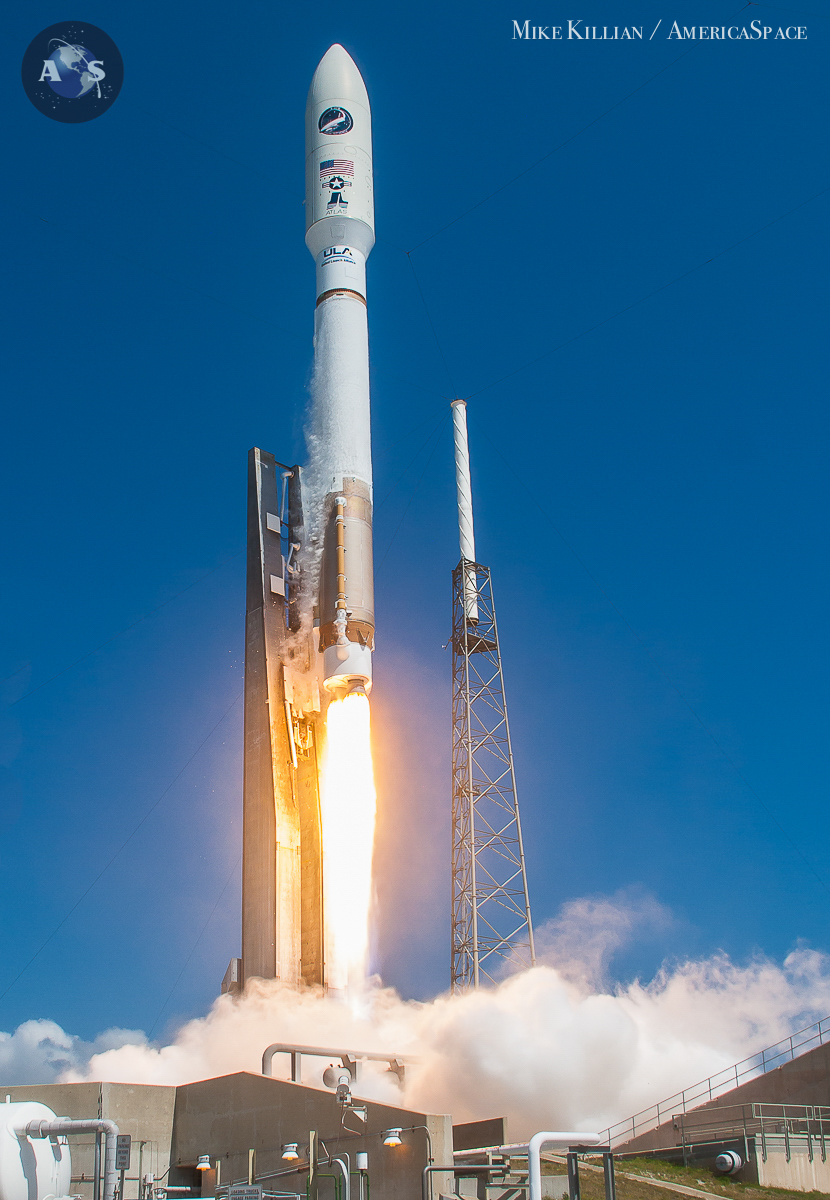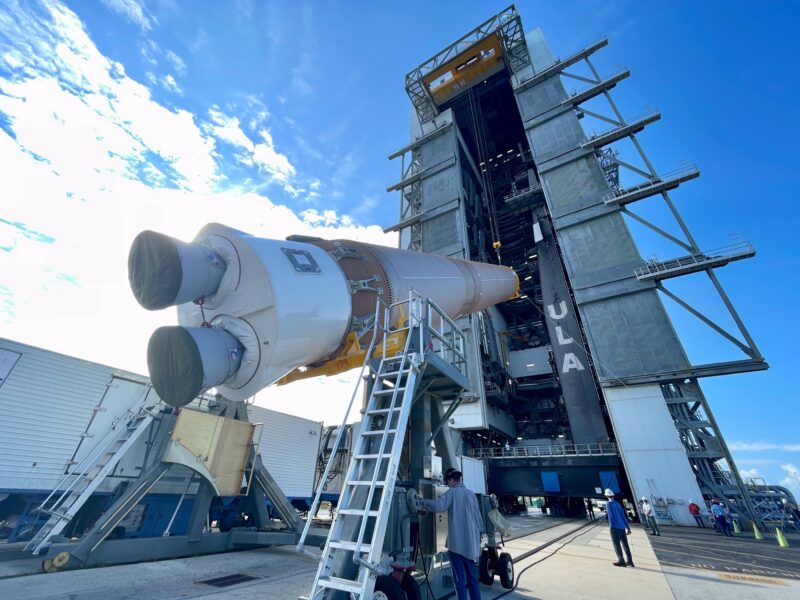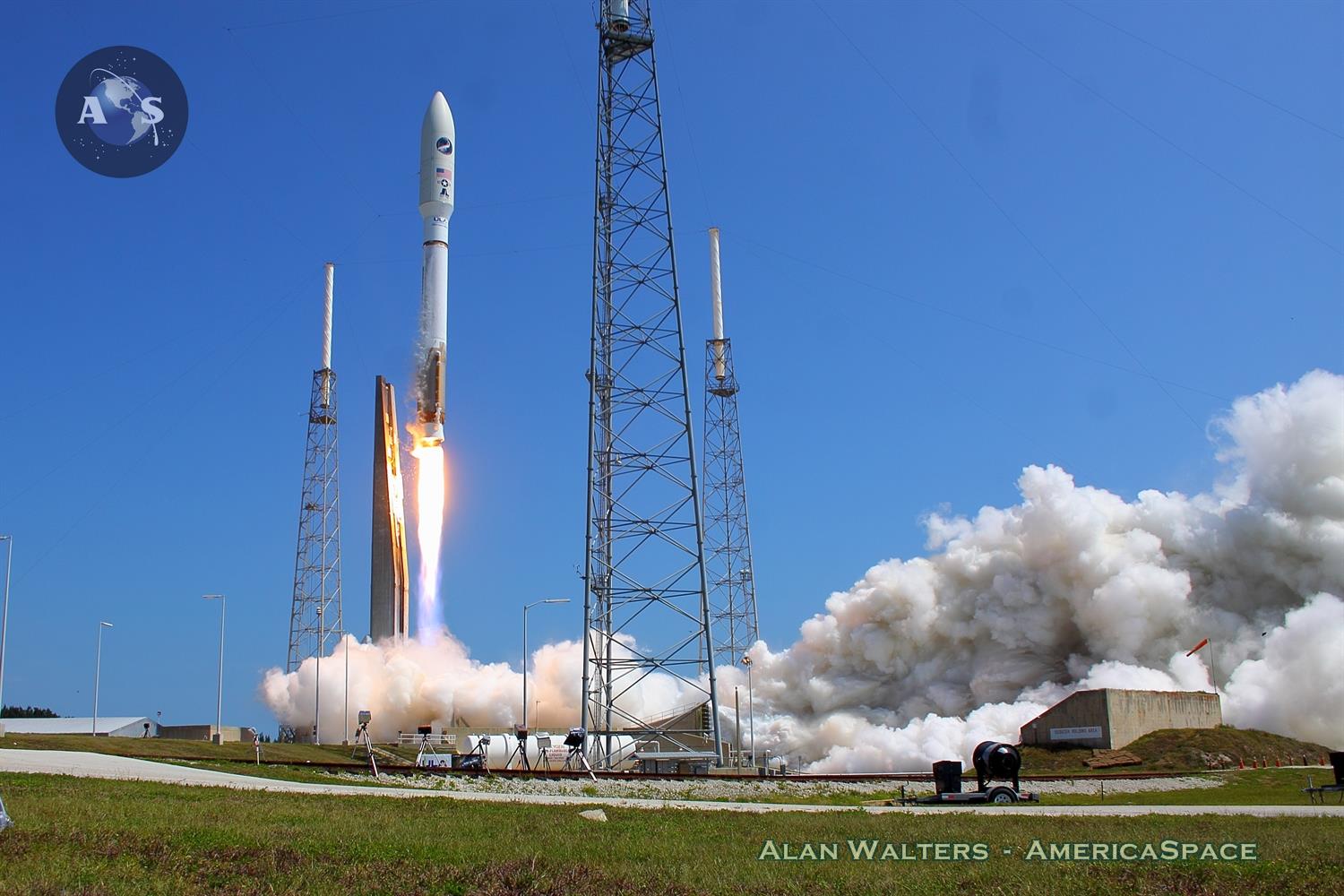
After one of its “lightest” years on record, in terms of missions at least, United Launch Alliance (ULA) will pick up the pace tomorrow, when it flies the second “Mighty Atlas” of 2023 out of storied Space Launch Complex (SLC)-41 at Cape Canaveral Space Force Station, Fla. Aboard the powerful Atlas V booster—making its 99th outing and eighth in the “501” configuration, equipped with a 17.7-foot-diameter (5.4-meter) Short Payload Fairing (SPF), no strap-on boosters and a single-engine Centaur upper stage—will be the first prototype pair of satellites for Amazon’s Project Kuiper broadband internet network.
Weather conditions along the Space Coast are predicted to be around 80-percent-favorable, characterized by scattered clouds, possible isolated showers, good visibility and temperatures hovering around 27 degrees Celsius (81 degrees Fahrenheit). Earlier on Wednesday, the Launch Readiness Review (LRR) was concluded, under the leadership of ULA Launch Director James Whelan, and produced a definitive “Go” status.
Unveiled by Amazon in 2019, Project Kuiper—whose intended constellation size of 3,236 satellites alludes to the colossal Kuiper Belt of icy bodies in the outer Solar System—is intended to increase global high-speed, low-latency broadband access and help close the “digital divide”, particularly in underserved regions of the United States and worldwide. “We’re determined to make affordable broadband a reality for customers and communities around the world,” said Amazon founder and CEO Jeff Bezos.

According to Amazon, Project Kuiper will serve a “wide range of customers”, including individual households, schools, hospitals, businesses, government agencies, disaster relief operations, mobile operators and organizations operating without reliable internet connectivity. The in-house system leverages Amazon’s global logistics and operations “footprint”, as well as Amazon Web Services (AWS) networking and infrastructure “to serve a diverse, global customer base”.
“We’ve designed our satellites and dispenser system to accommodate multiple launch vehicles,” said Project Kuiper’s vice president of technology, Rajeev Badyal. “This gives us the flexibility to use many different rockets and providers to launch our satellite system.”

In October 2020, the Federal Communications Commission (FCC) voted unanimously to approve Project Kuiper. And over the following two years, Amazon unveiled designs for the satellites’ Ka-band phased-array antennas to be used in customer terminals, announced substantial investment in prototype manufacturing facilities in Redmond, Wash., and unveiled a trio of outdoor-mounted customer terminal designs.
Last year, Amazon signed the largest commercial launch-vehicle procurement contract in history for up to 83 launches over a five-year period. Key providers are ULA’s Vulcan-Centaur, Kent, Wash.-headquartered Blue Origin’s New Glenn and Europe’s Ariane 6, developed by Paris, France-based Arianespace.
“Securing launch capacity from multiple providers has been a key part of our strategy from Day One,” said Badyal. “This approach reduces risk associated with launch vehicle stand-downs and supports competitive long-term pricing for Amazon. These large, heavy-lift rockets also mean we can deploy more of our constellation with fewer launches, helping simplify our launch and deployment schedule.”
Under the April 2022 contracts, Paris, France-based Arianespace will fly 18 missions in support of Project Kuiper, whilst Blue Origin will launch 12 times (with an option for 15 more) and ULA is tasked with 38 Vulcan-Centaur flights. It was noted that the ULA portion of the contract also covered “production and launch infrastructure to support a higher cadence of launches” from SLC-41, “including a new, dedicated version of the Vulcan Launch Platform (VLP)”.

Only days after the mammoth deal was announced, in May of last year ULA named Chris Ellerhorst, previously director of strategy, business development and sales, as vice president of its new Kuiper Program Office. Mr. Ellerhorst’s appointment, explained ULA CEO Tory Bruno, reflected the status of Amazon as “an important customer with an exciting and meaningful mission”.
In support of Project Kuiper, ULA is also developing a second vehicle processing facility to create parallel “launch lanes” for these high-cadence operations. The 38 Vulcan-Centaur missions followed an April 2021 contract for nine Atlas V launches to deploy the initial members of Project Kuiper from SLC-41, bringing to 47 the total number of flights presently on ULA’s ticket.
In April 2023, Amazon reported its intent “to launch two prototype satellites to test the entire end-to-end communications network” before year’s end, with an expectation that Project Kuiper “plans to be in beta with commercial customers in 2024”. These dual “Protoflight” satellites will be directly inserted by Friday’s Atlas V into low-Earth orbit, at an altitude of 311 miles (500 kilometers), inclined 30 degrees to the equator.
On 16 September, the time-honored Launch Vehicle On Stand (LVOS) campaign got underway, as the 107-foot-long (33-meter) Common Core Booster (CCB) was hoisted vertical into SLC-41’s Vertical Integration Facility (VIF). It was later joined by the interstage segment, the rocket’s Centaur upper stage and the “boattail”, which forms the lowermost portion of the payload fairing.

Last week, ULA announced that it was targeting no earlier than 2 p.m. EDT on Friday, 6 October, to launch the Protoflight and on 28 September the payload fairing housing the two satellites was mounted atop the Mighty Atlas, topping off the stack at 196 feet (59.7 meters) tall. With the Atlas V’s CCB powering the stack for its initial uphill climb, the Centaur will execute a single “burn” to deploy the Protoflight satellites—designated “KuiperSat-1” and “KuiperSat-2”—into their desired orbits about 18 minutes after launch.
After deployment, Amazon will assume primary command of the satellites. The Protoflight is expected “to add real-world data from space to Amazon’s results from its extensive lab testing, fieldwork and simulation,” noted ULA, “and help Amazon finalize plans ahead of a full-scale satellite deployment beginning in 2024.”

Making the eighth flight of its career, the 501 variant of the Atlas V launched most recently back in May of 2020. First flown back in April 2010, it has successfully delivered five flights of the U.S. Space Force’s Boeing-built X-37B long-duration mini-shuttle and a pair of highly secretive payloads—NROL-41 in September 2010 and NROL-39 in December 2013—for the National Reconnaissance Office.
Tomorrow’s weather looks around 80-percent-favorable, according to the Space Force’s Space Launch Delta 45 weather squadron and Launch Weather Officer (LWO) Melody Lovin, improving to 85 percent in the event of a 24-hour slippage to Saturday. “By Friday, the ridge across the eastern Continental U.S. weakens and shifts into the North Atlantic, loosening the pressure gradient and thereby our winds and moisture levels in time for launch day. Showers and thunderstorms cannot be completely ruled out but should be on the isolated side Friday afternoon.”






5 Comments
5 Pings & Trackbacks
Pingback:ULA Launches Third Mission of 2023, Looks Ahead to Maiden Vulcan Flight - AmericaSpace
Pingback:Vulcan-Centaur Stacking Underway, ULA Aims for Christmas Eve Launch - AmericaSpace
Pingback:Vulcan-Centaur Stacking Underway, ULA Aims for Christmas Eve Launch - SPACERFIT
Pingback:Vulcan-Centaur Rolls to Pad, Completes Last Major Pre-Launch Milestone - AmericaSpace
Pingback:Vulcan-Centaur Rolls to Pad, Completes Last Major Pre-Launch Milestone - SPACERFIT